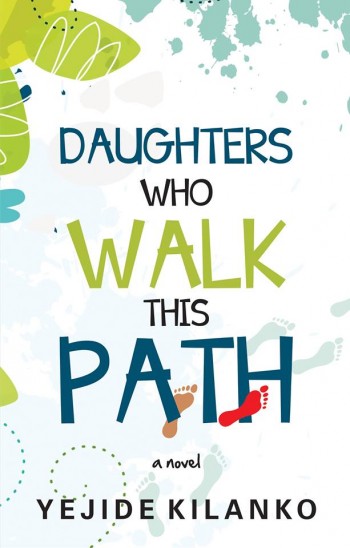Pub. Date (Nigerian Edition): October 2, 2013. Farafina. 264 pp. Buy Paper Back and Kindle
The world abounds with novels about violence against women. So why should you read Daughters Who Walk This Path, Kilanko’s rewrite of a motif that has inspired everyone from Shakespeare (Rape of Lucrece) to Alice Walker (The Color Purple)?
You should because Kilanko does smart and masterful things with the genre.
It’s the 1980s in Ibadan, the city of seven hills and little Morayo is as happy as a lark. Kachi, the boy she’s been crushing on has made it clear that the feelings are mutual. Her friendship with Tomi is a source of the simple joys of childhood. Eniayo, her younger albino sister is growing up to be a lovely and chirpy little girl. Dad and mom are doing well. They’ve just moved from a rented three-bedroom flat to a new two-story complex built from scratch. But this picture-perfect world comes down in a crash one unsuspecting day. Morayo’s near blissful life is abruptly and quite savagely cut short by an act of sexual violence.
Kilanko does a fine job of laying bare the psychic life of a girl who walks the paths to becoming a woman, all the while, burdened with a body badly in need of mending. There is a series of beautifully tragic moments when it becomes apparent that even as Morayo grows older and tries to live a normal life, she hasn’t yet survived the violence in her past. She is still held captive by that defining moment of trauma. Desperately seeking a way out, Morayo turns against herself, her body. “Disgusted by the image in the mirror,” she reasons that the only way to live with her damaged body is to do more violence to it.
Daughters Who Walk This Path is not for this reason entirely a voyeuristic excursion into the disturbed mind of an abused woman. Instead, Kilanko makes the question of Morayo’s survival the organizing principle of the novel. Morayo goes through life confused about where and how to find healing, how to stem the fear that she’d never be able to love or be loved. All this is, of course, heartbreaking stuff but what really gets the reader is how the question of redemption plays out. When the moment of truth comes and Morayo finds she has to face up to her past, she is not alone. There is someone there, and it is truly a beautiful moment to behold.
In a sense, Kilanko’s novel shows us why it is not enough to keep telling stories about how women become hurt and then turn against themselves. She shows us why the political capital in these kinds of stories and their real narrative beauty lie in the possibility that these women can find recovery through their own courage, through the support of other women, through friendships, community, and love.
It is no secret that African readers are becoming increasingly bored with novels that have nothing to offer except their claim to addressing some grand political or social issue. Kilanko’s work is not that kind of novel. All that is riveting and memorable about Daughters Who Walk This Path derives entirely from the sheer narrative power of the story. This is because Kilanko channels the trauma and abuse of her character into a powerful story about love, the recovery of self and body and the possibility of happiness.
When all is said and done, Kilanko’s novel is an account of how true love remains beautiful even when it blooms from within the sands of hurt and loss.










Book Review + Discussion Guide: Daughters Who Walk This Path | Like Bears to Honey March 04, 2016 12:49
[…] Brittle Paper writes an interesting review of this book […]